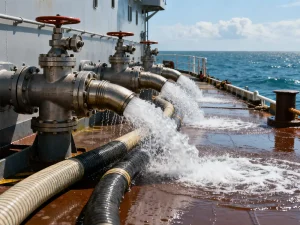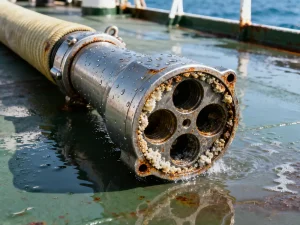Las mangueras son de distintos tipos y responden a necesidades diferentes. Algunas son grandes y se utilizan a escala profesional, por ejemplo, mangueras marinas. Por otro lado, algunas mangueras tienen un diámetro menor y se utilizan en los hogares. La presión del agua en estas mangueras pequeñas puede llegar a ser demasiado baja. Esto plantea una pregunta: ¿Cómo aumentar la presión del agua de las mangueras?
Cabe destacar que las mangueras con una presión de agua muy baja son poco prácticas para la mayoría de las actividades. Disponer de la presión adecuada garantiza que pueda realizar sus tareas de limpieza y otros trabajos con eficacia. Este problema suele ser común en las mangueras de jardín utilizadas en los hogares. En este artículo, le daré consejos para aumentar la presión del agua de su manguera. Así que, ¡comencemos!
¿Por qué es importante la presión de las mangueras?

La presión del agua de la manguera es la fuerza que empuja el agua fuera de la manguera. Cuanto mayor sea la fuerza, más rápido saldrá el agua de la manguera, y viceversa. En la sección siguiente, explicaré por qué es fundamental que la presión del agua de la manguera sea equilibrada.
- Si la presión del agua es demasiado baja, el agua tardará más en salir. Además, el agua no llegará más lejos debido a su menor presión.
- La presión del agua es esencial tanto para la limpieza como para la jardinería. Si la presión es demasiado baja, el agua no podrá eliminar el polvo. Del mismo modo, una manguera con menos presión de agua no rociará todo el jardín.
- Las mangueras se utilizan mucho en los lavaderos de dinero. ¿Verdad? Si la presión del agua es demasiado baja, ésta no eliminará la suciedad de los coches. Tendrá que frotar las partes de la carrocería para eliminar la suciedad o la mugre.
- ¿Ha visto alguna vez toberas de presión? Estas boquillas se utilizan generalmente para aumentar el chorro de agua. Si la presión del agua de la manguera es inferior a 35 PSI, estas boquillas no funcionarán. Esto significa que el agua de la manguera no viajará más lejos. Además, no podrá rociar el agua en tal caso.
- Cabe señalar que una presión de agua muy alta en la manguera también es desventajosa. Supongamos que está clasificada para transportar agua a 65 PSI. Si el agua en el interior es de alrededor de 80 PSI, la manguera puede dañarse. También verá problemas de fugas en la manguera. Tener una presión de agua de la manguera equilibrada es fundamental para todas las actividades al aire libre.
¿Cómo aumentar la presión del agua de la manguera?
¿Tiene problemas con las mangueras de baja presión? Si es así, no está solo: todas las mangueras pueden desarrollar este problema con el tiempo. En la sección siguiente, voy a discutir consejos y soluciones para arreglar la baja presión de agua en la manguera. Recuerde que la baja presión de agua puede deberse a cualquiera de las razones que se mencionan a continuación.
1- Limpiar la boquilla de la manguera

¿Su manguera tiene una boquilla en un extremo? Si es así, primero debe comprobar si esta boquilla funciona correctamente. Recuerde que algunas mangueras manipulan agua dura durante su uso. Esta agua dura contiene impurezas y minerales que pueden acumularse en esta boquilla. Esta acumulación de minerales en la boquilla puede afectar al caudal de agua.
La fuente proporciona un caudal de agua decente, pero la obstrucción de la boquilla reduce la presión del agua. Recomiendo retirar la boquilla de la manguera y limpiarla con cuidado. Esta limpieza de la boquilla debe ser su primera consideración cuando note que el agua de la manguera gotea por la cara. Debe comprobar la boquilla periódicamente para garantizar un rendimiento óptimo.
2- Compruebe si hay fugas en la manguera
¿Su manguera es muy vieja? Si es así, la baja presión puede deberse a una fuga. Por lo general, ignoramos las fugas en las mangueras, que pueden afectar al caudal de agua. Estas fugas pueden producirse en el punto de conexión o en la superficie de la manguera. Puede comprobar si hay fugas conectando la manguera a la fuente de agua y cerrando el otro extremo con la mano.
Cuando aumente la presión, el agua empezará a salir por los puntos más débiles. Éstos son los puntos por los que suele escaparse el agua, lo que provoca una baja presión. Puedes cerrar las fugas con cinta impermeable si no quieres cambiar la manguera. El problema de las fugas puede ser desastroso si se produce en marinas o mangueras mineras.
3- Desplazar las partículas atrapadas
A veces no guardamos la manguera con cuidado y la dejamos sin revisar durante meses. Durante este periodo, algunas partículas, incluidos los residuos, pueden entrar en la manguera y acumularse en ella. Con el tiempo, estos residuos se adhieren a la superficie de la manguera y no salen fácilmente.
Si empieza a utilizar una manguera de este tipo, sin duda se encontrará con problemas de baja presión. Para ello, debe retirar la manguera y mantener el agua abierta. El agua debe correr por la manguera durante 15 minutos para aflojar los residuos acumulados. Transcurridos los 15 minutos, empiece a agitar la manguera mientras el agua sigue corriendo por ella. Esta agitación eliminará todas las partículas atrapadas.
Lo más destacado: Si no elimina las partículas atrapadas, pueden degradarse lentamente en el agua y fluir hacia la boquilla. Como resultado, causarán obstrucciones en la boquilla de la manguera. Recuerde que si la boquilla de la manguera recibe partículas, tendrá que limpiar tanto la boquilla como la manguera. En el peor de los casos, es posible que también tenga que sustituir la boquilla, lo que puede ser un poco más costoso.
4- Retorcimiento de la manguera

Las mangueras de goma son flexibles y pueden doblarse, ¿verdad? Esta flexión o torsión puede ser muy perjudicial para el rendimiento de la manguera. Cuando la manguera se dobla, el paso del agua en su interior se bloquea. Por lo tanto, muy poca agua puede pasar a través de este punto bloqueado, lo que resulta en una baja presión de agua.
Peor aún, el retorcimiento puede bloquear completamente el flujo de agua. Este retorcimiento severo puede causar fugas en la manguera. Recuerde, cuando la presión dentro de la manguera es demasiado alta, el agua puede ejercer fuerza sobre las paredes de la manguera, causando fugas. Antes de utilizarla, elimine siempre los pliegues y asegúrese de que la manguera está recta.
5- Conexiones de mangueras y racores estancos
Hay diferentes puntos de conexión en la manguera. Por ejemplo, la primera conexión está entre la manguera y el grifo. La segunda conexión suele estar entre la boquilla y las mangueras. Del mismo modo, si hay más suministros de esa manguera, habrá más conexiones. Le recomiendo encarecidamente que apriete bien todas las conexiones.
Generalmente, estas conexiones quedan débiles o sueltas. Cuando sale agua a alta presión por la manguera, la conexión suelta empieza a tener fugas. Como resultado, se desperdicia agua, lo que provoca un flujo de baja presión de la manguera. También puede colocar una goma elástica en el punto de conexión para reducir aún más el riesgo de fugas.
6- Reducir la longitud y aumentar el diámetro de la manguera
Esta solución no es ideal en la mayoría de los casos cuando baja la presión del agua. ¿Por qué? Porque no puede cortar la manguera cuando necesita suministrar agua a larga distancia. Sin embargo, puede reducir el tamaño de la manguera cuando riegue el jardín. Una manguera más corta aumentará la presión del agua.
Por otro lado, siempre debe elegir mangueras con un diámetro mayor si prefiere una presión de agua elevada. Recuerde que una manguera de diámetro reducido nunca es una buena opción si desea rociar agua a gran distancia. Si ya tiene una manguera, no puede aumentar su diámetro. Sin embargo, supongamos que vas a comprar una manguera nueva. En ese caso, te recomiendo que utilices una manguera de mayor diámetro para mejorar la presión del agua.
7- Utilice un elevador de presión
¿Ha seguido todos los consejos mencionados anteriormente y sigue teniendo poca presión de agua en la manguera? En tal caso, no hay nada malo con la manguera; el problema radica en su línea principal de suministro de agua. Esto significa que la conexión de agua principal de su casa está experimentando baja presión de agua. Como resultado, todos los grifos, mangueras y llaves están experimentando baja presión.
En tal caso, debe instalar un elevador de presión en la tubería principal de suministro de su vivienda. ¿Ventajas? Este elevador de presión aumenta la presión del agua que entra en su casa. Como resultado, todos los grifos y mangueras de su casa ofrecerán una presión de agua excelente. Recuerde que esto sólo debe hacerse cuando esté seguro de que su casa recibe poca presión de agua municipal.
Preguntas frecuentes
¿Por qué mi manguera tiene poca presión?
Puede haber múltiples razones para la baja presión de la manguera. Su lista incluye:
- Manguera demasiado vieja
- Problema de fuga en la manguera
- Minerales o residuos acumulados en el interior.
- Retorcimiento de la manguera, causando bloqueo u obstrucción
¿Cómo hacer que una manguera de agua tenga más presión?
Debe limpiar la boquilla de la manguera para aumentar la presión. Además, debe cerrar cualquier fuga y eliminar la acumulación de residuos de las mangueras. Además, mantener la manguera de agua recta para evitar que se doble puede mejorar la presión del agua.
¿Cómo puedo saber si la presión del agua es baja?
Por lo general, puede comprobar el caudal y la dirección del agua con los ojos. Además, puede utilizar un manómetro para comprobar la presión exacta del caudal. Recuerde que un caudal de agua con una presión superior a 40 PSI se considera una presión decente. Una presión por debajo de este rango (40 PSI) puede ser problemática.
Conclusión
Todos los tipos de mangueras, incluidas las de material compuesto o submarino mangueras e incluso mangueras de dragado, tienen una presión nominal específica. Si la presión es demasiado baja, puede afectar al rendimiento de la manguera. Por lo general, las mangueras de gama alta no experimentan problemas de baja presión debido a la robustez de sus materiales.
Sin embargo, las mangueras de jardín son flexibles y pueden experimentar una caída de presión. Recuerde que los problemas de baja presión en las mangueras pueden deberse a múltiples razones. En este artículo, he tratado siete soluciones clave para arreglar los problemas de baja presión. Si tu manguera es demasiado vieja o tiene fugas, te recomiendo que compres una nueva en lugar de arreglarla.
